The southeastern province of Sistan and Baluchestan in Iran was once again thrust into the international spotlight on August 22, 2025, after a deadly attack claimed the lives of five Iranian police officers. According to multiple news agencies, including the official IRNA and Shafaq News, the officers were patrolling in two police vehicles near the city of Iranshahr—about 1,300 kilometers (800 miles) southeast of Tehran—when they came under fire from armed assailants.
The attack, which took place in the Daman district, was quickly claimed by Jaish al-Adl, or the Army of Justice, a militant group that has long opposed the Iranian government. In a statement released on its Telegram channel, the group said its fighters had targeted the two police patrols, exchanging gunfire before fleeing the scene. Iranian police later confirmed the assault and stated that an "extensive search operation" had been launched in pursuit of the attackers, as reported by Shafaq News.
While the immediate aftermath was chaotic, with authorities scrambling to secure the area, the incident is far from isolated. Sistan and Baluchestan, Iran's largest province by land area, shares borders with both Afghanistan and Pakistan and has become a hotbed for sporadic clashes involving militant groups, armed drug smugglers, and Iranian security forces. The region is one of Iran's least developed, and its complex social fabric—comprised largely of Sunni Baluchis—has long been a source of tension with the predominantly Shia central government.
According to The Jerusalem Post, dashboard camera footage from the attack showed Jaish al-Adl militants opening fire on a police vehicle in the middle of the highway. The officers and militants exchanged gunfire before the attackers drove away. The police identified one of the victims as Sgt. Ramin Sadeghi. The brazen nature of the assault, occurring in broad daylight, underscores the growing confidence of militant groups operating in the area.
Iran International reported that, just last week, Sunni militants killed one police officer and injured another in a similar attack on a vehicle in Iranshahr. These incidents are part of a troubling pattern of violence that has plagued the region for years. Jaish al-Adl, in particular, has been linked to a string of high-profile attacks, including a deadly assault last month on a courthouse in Zahedan, the provincial capital. That attack, which involved both gunfire and grenades, left six people dead—including a child—and wounded 20 others, according to reports from AP and The Jerusalem Post.
The Iranian government has long accused groups like Jaish al-Adl of having ties to foreign powers and of being involved in cross-border smuggling and insurgency. Tehran often points to the porous borders with Afghanistan and Pakistan as both a logistical challenge and a security risk. The province's geography—arid, mountainous, and difficult to police—has made it an attractive haven for militants seeking to evade Iranian authorities.
Jaish al-Adl, which translates as "Army of Justice," is a Sunni militant group that emerged in 2012 as a successor to the now-defunct Jundallah organization. Its stated aim is to fight for greater rights and autonomy for the Baluchi people, who have long complained of discrimination and neglect by the central government. The group has repeatedly targeted Iranian security forces, particularly the police and the Islamic Revolutionary Guard Corps (IRGC), in a bid to draw attention to their cause. The Iranian authorities, for their part, have labeled Jaish al-Adl a terrorist organization and vowed to crush its activities.
Friday's attack is likely to intensify the already heavy security presence in Sistan and Baluchestan. In the wake of the assault, Iranian police announced a sweeping search operation, though no arrests were immediately reported. The attackers managed to escape, adding to the frustration of local authorities and fueling public anxiety. As Shafaq News noted, such incidents have "grown more frequent along Iran’s borders," raising questions about the government's ability to maintain order in the restive southeast.
The timing of the attack is also notable. Sistan and Baluchestan has experienced a surge in violence over the past year, with militants stepping up their operations against state targets. In addition to the attacks on police and court buildings, there have been reports of assaults on IRGC bases. In one recent incident near Aghlan village in Sardasht, West Azerbaijan province, a Basij member—a volunteer force linked to the IRGC—was killed and another wounded in a shooting, according to Shafaq News.
For many residents of Sistan and Baluchestan, life is marked by uncertainty and fear. The province's underdevelopment, coupled with high unemployment and a lack of economic opportunities, has created fertile ground for discontent and radicalization. While the government has invested in infrastructure and development projects, critics argue that these efforts have failed to address the root causes of instability. The sense of alienation among the Sunni Baluchis remains strong, fueling support for groups like Jaish al-Adl.
Iranian authorities have responded to the violence with a combination of military crackdowns and promises of reform. However, the cycle of attack and retaliation shows little sign of abating. As The Jerusalem Post observed, "Iran's southeast has been the scene of sporadic clashes between security forces and armed groups, including Sunni militants and separatists who say they are fighting for greater rights and autonomy." Tehran’s accusations that some of these groups are supported by foreign states only add another layer of complexity to an already volatile situation.
Meanwhile, the families of the slain officers—like Sgt. Ramin Sadeghi—are left to mourn their loss, a grim reminder of the human cost of the conflict. For the Iranian police and military, the challenge is daunting: how to secure a vast and restive region without further alienating its population or fueling the grievances that sustain the insurgency.
As the search for the attackers continues, the people of Sistan and Baluchestan are bracing for what comes next. The latest violence has once again laid bare the deep-seated tensions that define the province and the formidable obstacles facing those who seek peace and stability in Iran’s troubled southeast.


